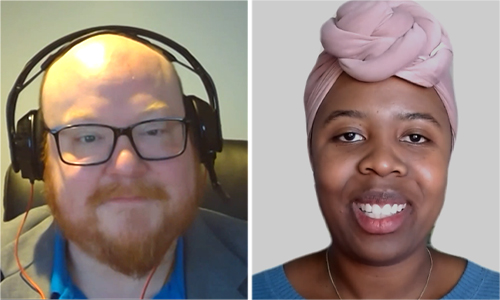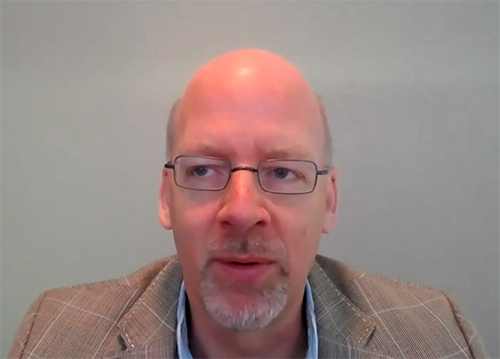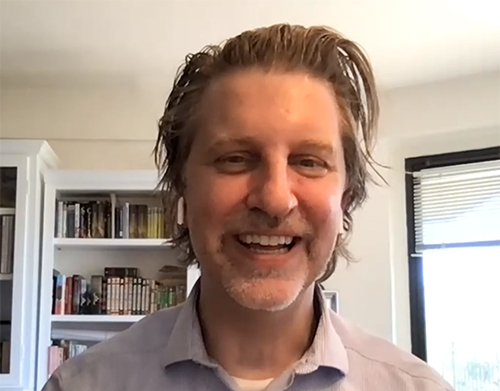Fueling Scientific Discovery and Communication
This year's virtual National Synchrotron Light Source II & Center for Functional Nanomaterials Users' Meeting featured 12 scientific workshops and two plenary sessions, showing the breadth of scientific discoveries at both national user facilities
September 15, 2021

UPTON, NY—This year’s virtual Joint Users’ Meeting of the Center for Functional Nanomaterials (CFN) and the National Synchrotron Light Source II (NSLS-II)—two U.S. Department of Energy (DOE) Office of Science User Facilities at DOE’s Brookhaven National Laboratory—attracted 1,100 registered attendees, from 38 countries, to join the scientific discourse. The meeting was held virtually from May 17 to 20, and featured two plenary sessions and 12 workshops.
For the past few decades, holding the annual Joint Users’ Meeting during the warm spring days on Long Island has been a long-standing tradition at Brookhaven Lab; however, with the ongoing pandemic, the two organizing Users’ Executive Committees (UECs) chose a virtual setting for this year’s meeting. This format allowed for far more attendees and workshops than a physical conference under normal circumstances.
What the future holds for users of both facilities

This year's meeting was co-moderated by Trishelle Copeland-Johnson, the CFN UEC co-chair, and Matthew Whitaker, the NSLS-II UEC chair.
Trishelle Copeland-Johnson, the CFN UEC co-chair, and Matthew Whitaker, the NSLS-II UEC chair, welcomed attendees to the meeting during the Strategic Plenary Session. They conveyed their excitement about this year’s meeting as they announced the first speaker of the day: Brookhaven Lab Director Doon Gibbs. In his welcoming words, Gibbs highlighted the essential role that Users’ Meetings play as forums for communication in the scientific world.
John Hill, NSLS-II Director, began his presentation by sharing the NSLS-II motto: “Together, we shine light on the world’s most challenging problems.” Hill noted how this motto encapsulates what NSLS-II is all about: working with users to apply state-of-the-art synchrotron techniques to tackle some of the most important problems facing society today - a fact that has not changed because of the pandemic. With pride, Hill cited that NSLS-II ran more than 800 proposals last year —a remarkable testament to the staff members’ commitment to meeting the facility’s mission, even under the most trying of circumstances. He went on to report that 2020 was a record year for the number of publications citing use of NSLS-II, with over 570 papers published, more than 40 percent of which appeared in journals with a high impact factor greater than seven.

During this year's presentation, NSLS-II Director John Hill spoke about how the pandemic merely accelerated the implementation of remote capabilities at NSLS-II.
Hill then spoke about remote operations. “Even though we implemented our remote access capabilities in response to the pandemic, it merely accelerated a trend that was underway already. Therefore, such operations are here to stay. Remote operations are supported by our data vision for the facility, which also includes machine learning and artificial intelligence tools to augment all stages of experiments. Some of these are already coming online.”
Hill ended his talk by discussing ideas for 19 new beamlines prompted by community engagement. These beamlines would complement and extend the current portfolio of research capabilities, particularly supporting multimodal research. Finally, he mentioned early ideas for a source upgrade that would increase the brightness by a factor of 10 at 1 kiloelectronvolt (keV) and 100 at 10 keV.
Following Hill, CFN Director Chuck Black described three lessons learned from 2020 that are important to the future of the CFN.

CFN Director Chuck Black encouraged users to participate in ongoing pilot studies to help shape the path forward for creating the most productive remote CFN experience.
Black saw the first lesson, “We work together. We don’t panic,” reflected in the facility’s supportive culture during the pandemic. Through this strong collaboration, users and staff, working together, co-authored half of all CFN publications in 2020. For his second lesson, “We are adaptable. We are resilient,” Black spoke about the increased number of remote users supported by the facility in both years. He described the three pillars of this remote support effort, or Remote@CFN: remote engagement, remote instrument operation, and remote data access. Black encouraged users to participate in ongoing pilot studies to help shape the path forward for creating the most productive remote CFN experience. Black also shared several new capabilities added to the CFN instrument portfolio: a dual-beam microscope, atomic layer deposition system, x-ray diffractometer, and electron energy-loss spectroscopy in an environmental transmission electron microscope.
Black’s third lesson was “We must dare mighty things.” He highlighted several “mighty things” currently under development at the CFN, including the Quantum Material Press (QPress)—a first-of-its-kind robotic platform to synthesize and characterize two-dimensional materials—and an at-home, cell-phone-based COVID-19 test. In ending his presentation, Black reiterated the core commitment of the CFN to work together to ensure CFN users can also dare mighty things.
“Our world has big challenges that science must solve,” said Black. “This is our chance, our opportunity, to really do work that matters.”
The final speaker of the Strategic Plenary Session was Linda Horton, the Associate Director for Science for Basic Energy Sciences in the DOE Office of Science, who said she was delighted to return to the virtual Users’ Meeting as a keynote speaker. Horton began by presenting leadership changes at the DOE and introducing the wide range of capabilities the Office of Science supports each year, before turning to the impact of the pandemic.
“The light sources were really engaged in the characterization of the COVID-19 virus for the development of vaccines. They determined more than 350 protein structures related to the virus or its vaccines. However, this is very small compared to the decades of contributions of the light sources to drug development overall,” said Horton. “Not only the light sources were part of our national response to the pandemic, but also the nanocenters supported studies on how we can better combat viruses such as COVID-19 by investigating the effectiveness of masks or designing antiviral coatings using nanoparticles.”
The DOE not only learned scientifically from this pandemic - Horton also stressed that they are working on a report based on roundtable discussion regarding essential topics, such as remote operations and effective communication.
In the rest of her presentation, she spoke about the various resources the department offers, from reports on state-of-the-art research activities to various funding opportunities for a wide variety of research topics, such as microelectronics, chemical sciences, data sciences, and infrastructure improvement.
Once the talks had concluded, the audience had the opportunity to ask questions to all speakers, leading to a lively discussion about research opportunities.
From single-molecule circuits to seafloor minerals
The next day, meeting attendees came together for the scientific plenary, which included three scientific presentations. The first scientific presentation, titled “Physics and Chemistry of Single-Molecule Circuits,” was presented by Latha Venkataraman, Lawrence Gussman Professor of Applied Physics and Professor of Chemistry at Columbia University.
Following this first keynote, James Fraser, Professor, Department of Bioengineering and Therapeutic Sciences at University of California San Francisco, spoke about “Targeting COVID-19 Viral Enzymes in an Evolving Landscape of Publishing and Peer Review.”
In the final presentation, Brandy Toner, Professor at the College of Food, Agricultural, and Natural Resource Sciences at University of Minnesota, spoke about “Seafloor Sulfide Minerals are Microbial Hot-spots in the Deep, Cold, and Dark Ocean.”
The session also included presentations by the awardees of the Julian Baumert Award and the Chasman Award about their research projects. This year’s award session included both last and this year’s awards.
For those who missed the event, the UECs have uploaded full recordings of all scientific and strategic presentations in the agenda on the Users’ Meeting website.
Just two facilities, but so many areas of science
This year’s Users’ Meeting featured 12 in-depth workshops on a wide range of scientific topics. Researchers presented scientific studies and results ranging from paleoanthropology to additive manufacturing processes, showing the true breadth of research done at both user facilities.
“The virtual platform allowed us to organize 12 excellent scientific workshops this year,” said CFN User Administrator Grace Webster, who organized the meeting together with NSLS-II User Administrator Gretchen Cisco and the two UECs. “They were all well attended, with attendees from 38 countries, some of whom indicated that they would not have been able to attend if the meeting was held in-person.”
Additional information, including full recordings, can be found for each of the following workshops:
- NSLS-II and CFN Microscopes 101: Techniques, Applications, and Access
- Correlating Structure and Properties in Additively Manufactured Metals through Multimodal Characterization Approaches Back
- Cryo-EM at LBMS: Protein Structures, Protein-protein and Protein-cell Interactions
- Ultrafast Pump Probe Optical Microscopy Techniques and their Applications in Nanoscience
- Characterization and Speciation of Marine Materials using Synchrotron Probes
- Exploring Future Collaborations Between NNSA and BNL/NSLS-II
- Scientific Python for Data Analysis at NSLS-II
- Towards the Next Generation of Photothermal and Near-Field Infrared Nanospectroscopy at the CFN and NSLS-II
- Structural Responses to Electronic Order in Quantum Materials from Total Scattering Approaches
- Liquid Surface Science
- Machine Learning Augmented X-Ray Scattering and Spectroscopies
- Unraveling the Past – Paleoanthropology and X-ray Imaging
Similar to last year’s successful virtual meeting, the NSLS-II and CFN UECs are still considering adding a virtual component to future in-person meetings. They hope the added virtual component will make the meetings more accessible to the scientific community.
NSLS-II and CFN look forward to hosting their next joint Users’ Meeting in 2022.
The two UECs would like to thank all sponsors of the 2021 joint User’s Meeting.
Brookhaven National Laboratory is supported by the U.S. Department of Energy’s Office of Science. The Office of Science is the single largest supporter of basic research in the physical sciences in the United States and is working to address some of the most pressing challenges of our time. For more information, visit https://energy.gov/science.
Follow @BrookhavenLab on Twitter or find us on Facebook.
2021-19007 | INT/EXT | Newsroom









